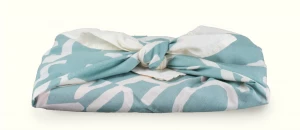The term 'carbon footprint' is familiar to anyone with an interest in sustainability. It is used to refer to the negative environmental impact of a certain product or production process, by that a t-shirt, mobile phone or car. But what does it actually mean? And why is it important? And, the biggest question of all, how is it calculated?
Minimising the environmental impact of your logistics - from how you source materials, manage your inventory and ship your products to how your customers dispose of them at the end of their usable life - is vital for any fashion business aiming to be as sustainable as possible. And, doing this while ensuring that you are maximising efficiency and ultimately profit is no mean feat.
The term 'carbon footprint' is, these days, as ubiquitous as denim jeans, but, sometimes, what it actually means and why it is important is a little more tricky to pin down.
Well, this Masterclass is here to answer all those questions - and more; featuring two interviews with brands that are leading the way, as well as a real life case study, demonstrating how to gather and interpret the kind of information that is needed in order to calculate the carbon footprint of a product.
We are going back to the basics of carbon footprints, looking at what they are, why they are important and how to calculate them. We break down the different areas and examine how businesses can improve their sustainability in the design and production phase, pre-consumer phase and post-consumer phase.
In this Masterclass you will learn:
- How to reduce carbon emissions in your business operations when selecting your materials and designing your products
- How to calculate the carbon emissions of your production process
- What a Life Cycle Assessment is, and how to conduct one
- About which areas of the production process are the most harmful
- How bamboo clothing brand BAM is measuring the impact of their garments
- How Earthly helps business to measure and reduce carbon emissions
-
The Carbon Footprint of Nettle Cotton Handloom Tweed - an Offset Warehouse case study
with The SFC TeamRead More...Summary
Here you'll find our example of the carbon footprint of a metre of fabric. We conducted a Life Cycle Assessment of fabric from our sister company, Offset Warehouse. We began by posing questions to the suppliers who grow the raw materials and weave the fabric, to ascertain how much carbon is released at every stage of the process. Find a list of the questions to ask your suppliers in our downloadable guide, How to Calculate the Carbon Footprint of your Products.
-
How to Calculate the Carbon Footprint of Your Products Downloadable
with The SFC TeamRead More...Summary
Attempting to calculate the carbon footprint of your products is complex. Especially if those products include different elements made in various locations. Trying to draw out as much information as possible from your suppliers is crucial. This downloadable questionnaire will provide a starting point for you to ask the right questions and identify the most carbon-intensive parts of your production.
-
Carbon Negative Furniture And Interiors
with Ardilla DeneysRead More...Summary
This is a bitesize 10 minute lesson from the founder and designer of Pollima, America's first CO2 negative furniture made from compressed agricultural waste hemp and soy fibre. Ardilla Deneys heads up this dreamy Lesson to help you understand business models and sustainable production methods for homewares, interiors and furniture that are helping to elevate this product area into the future.
Rather than just creating products, consider how you can utilise your ingenuity to reciprocate the gifted materials and resources of the Earth - whether through using a waste stream, ensuring customer engagement through rental and repair, or even supporting purchasing decisions with augmented reality.
Interviews
Additional Reading
Top Takeaways from The Regenerative Fashion Conference
Sunday Oct 1st, 2023
Building a Fashion Brand that is Successful, Profitable and Ethical
Friday May 6th, 20225 Sustainable YouTubers Every Environmentally Conscious Person Should Follow
Monday Feb 21st, 2022
Top Sustainability Textile Trade Shows All Designers Should Visit
Monday Feb 14th, 2022
Why Sustainable Fashion Brands Are Taking On Eco Homewares
Monday Dec 20th, 2021
In Conversation With: Kate Anderson, Ecosophy
Tuesday Dec 14th, 2021
Why we should use reusable packaging - and inspiration to make your own
Friday Dec 10th, 2021
Fashion Trend Forecasting: Vision, Colour and Materials 2022
Monday Dec 6th, 2021
In Conversation With: Kat Vandal, Vandal Kids
Wednesday Nov 24th, 2021
Why Sustainability In Wedding Fashion Is More Important Than Ever
Wednesday Nov 17th, 2021

